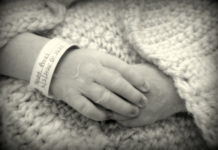I arrived a few minutes late, and saw the warehouse-size studio lit up with women wearing glowing white crop tops that said, “Love Yourself Now,” bodies moving in unison this way and that, in an epic session of ButiYoga.
My go-to exercise is weightlifting, but I enjoy pushing my comfort zone and challenging myself to try other forms of physical activity, so when my friend invited me to join her for an innovative yoga class, I figured I’d give it a whirl.
I can definitely say I had no idea what I was getting myself into…but I’m happy I got myself into it. And here are the thoughts that I walked away with:
Tznius was a topic well-addressed all through my school years.
So much so that it dictated the way I moved without me even being cognizant of it.
I didn’t know how to dance in a way that was natural.
I didn’t know how to express myself through movement in a way that was intuitive.
I didn’t know how to move my body in a way that was sensual.
I couldn’t do it on the women’s side of the dance floor at a simcha.
I couldn’t do it enveloped by the safety of a female-only fitness studio.
I couldn’t do it in the comfort of my own bedroom.
I was far too conscious of how it would seem to those around me.
I was far too conscious of the fact that this wasn’t the way I was taught.
I was far too conscious of my body wanting to do things I wasn’t familiar with.
ButiYoga pushed me out of that space. Without even realizing why I was doing what I was doing, I found the invisible walls I had built within myself slowly begin to fall away, as the music enveloped me, and a sense of peace steadily filled me with its warmth.
Uncertainly at first, I gave myself permission to follow along with the movements. I took it at my own pace, pausing when things got too uncomfortable, and then picking it back up again.
“Primal movement” and “tribal dance” were the terms I kept hearing in association with this form of exercise, and while I couldn’t quite ascertain exactly what they meant, I realized that my body knew. It had wanted to express itself in a way I couldn’t even relate to because I had been repressing that activity for so many years.
“Buti” is a Marathi Indian term for “the cure to something that’s been hidden away or kept secret”. I only found this out in my research for this article, and I’m amazed at how I absorbed that message without even being aware of it.
To be clear, I’m not talking about anything inappropriate. I’m not talking about anything I’d be uncomfortable with others seeing me do. I’m simply talking about moving my body.
Modesty is intuitive to me. I appreciate the value and power I contain within me, and I recognize that to hold back can be beautiful.
But I also know that we need a healthy balance.
Because modesty isn’t repression.
It’s learning how to access and give expression to all parts of ourselves in a way that is congruent with Torah values. And sometimes it’s uncomfortable, and sometimes it seems contradictory to the messages we’ve internalized, but ultimately, it’s so incredibly freeing.
Pesach celebrates the freedom from oppression of anything which detracts me from focusing on my relationship with G-d.
So much so, that I was taught to envision myself as if I had been freed from Mitzrayim. And then to plug that into my personal life.
So now I can say—
I welcome the challenge to learn what dancing naturally means to me.
I welcome the opportunity to learn how to express myself through intuitive movement.
I welcome the understanding that it’s ok to move my body in a sensual way.
I embrace the freedom to choose to join in with those on the dance floor.
I embrace the freedom to feel safe in a women-only fitness studio.
I embrace the freedom to be comfortable in my own bedroom.
I give myself permission to trust my inner voice, instead of those around me.
I give myself permission to challenge the simple, watered-down version of modesty I was taught.
I give myself permission to fully explore in the unfamiliar way that my body wants.
I’m still insecure about dancing in front of others, and when asked, I revert to my automatic “Oh, I don’t dance,” but now when I say it, there’s doubt in my voice.
Because I know that I can. And I know that I should. And I know that someday, G-d willing, I will.
Because movement is a non-verbal form of expression, and when I can get comfortable with it, I can use it to serve G-d.











